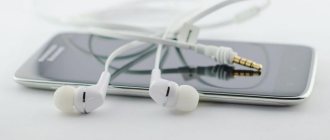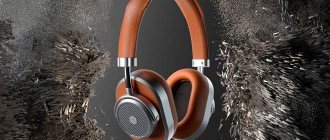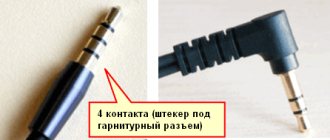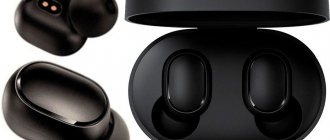Not all wireless headphones can match the sound quality of the best classic models, but they are confidently gaining ground in the market. The absence of inconvenient cords in this accessory covers up minor shortcomings, making the purchase unusually attractive, for example, for an athlete, a businessman, or a frequent traveler.
What are wireless headphones?
Relatively short and always tangled connection cords limit freedom when listening to music. Wireless headphones are devoid of cables, receiving a signal through a built-in radio or IR receiver at a relative distance from the station. The sound quality and range depend on the technology used in the headset. The advent of tiny chips has made it possible to make a mobile phone a transmitting device, so Bluetooth headphones are now seriously competing with conventional wired accessories.
Wireless headphone device
A simple headset consists of a body, speakers, a plug and wires. Wireless headphones with a microphone are a more complex stand-alone device; they have built-in batteries and a radio wave receiver. The case has a charging connector, a signal LED indicator, a speaker and a control panel (“volume”, “rewind”, “pause”, “shutdown”, “receive a call”). The location of the listed elements differs for different models. More complex products, for example, iPhone accessories, have proximity sensors and an accelerometer.
Pros and cons of wireless headphones
When advertising a fashionable new product, cunning sellers often keep silent about the visually hidden defects of the product. Even the best wireless headphones may not be suitable for a user accustomed to standard wired accessories. It is better to first consider what nuances you may encounter when using the latest Bluetooth headset.
Advantages of wireless headphones:
- No bending, restricting movement or tangling connection cables.
- The ability to listen to tracks or carry on a conversation at a distance from the transmitter.
- Advanced models with FM and a memory card make the headset even more independent from the mobile phone.
Negative aspects of a wireless headset:
- The headset's own battery requires periodic recharging.
- Wireless accessories are easier to lose.
- Music lovers note that most products have insufficient playback quality. Only expensive models, for example, wireless headphones for iPhone, produce great sound.
- The cost of Bluetooth headphones is more expensive compared to their wired counterparts.
Harm of wireless headphones
Developers and manufacturers prove that Bluetooth headsets are completely safe, but it is better to remember that any radio device emits waves into space. Large over-ear or small in-ear wireless headphones are no exception. Published reviews from owners, with a few exceptions, do not indicate the development of any dangerous pathologies after purchasing the gadget. Only a few people reported increased fatigue or headaches when using this accessory.
Recommendations for using wireless headphones:
- Buy products from trusted companies.
- Give preference to models with noise reduction.
- Try to limit the time you wear a Bluetooth headset.
- Do not use accessories at maximum volume.
Advantages and disadvantages of headphones
It is difficult to immediately determine which headphones are better - wired or wireless. You need to be guided by the characteristics and functionality. We have highlighted the common advantages and disadvantages of both types:
Wireless models
Advantages:
- No wire. According to statistics, every third headphone fails precisely because of damage to the plug. Wireless models are not affected by this, because The cable at the entrance does not get pinched and does not rub against clothing.
- Ease of use. You can take wireless headphones on a run or workout without worrying about where to put your smartphone. They do not depend on the cable length and operate within a radius of 9-10 meters.
- Increased functionality. Almost all Bluetooth headphones have voice control. Some models have a built-in pedometer or heart rate monitor.
Flaws:
- Working hours. The headphones need to be charged constantly. They are not powered by a smartphone like wired devices. In addition, the battery wears out over time and requires replacement. The average operating time is from 6-8 hours.
- Sound quality. Bluetooth headphones sound worse than wired ones.
- Price. The price tag for Bluetooth devices is much higher.
Wired models
Advantages:
- High quality sound. The wire provides high precision sound transmission.
- Affordable price. Using a Bluetooth module in a design is more expensive than using a cable. Therefore, wired headphones with equal characteristics will cost less than wireless ones.
- Connection stability. The transmitted signal is not interrupted, as is often the case with Bluetooth headphones.
Flaws:
- Risk of damaging the wire. Some manufacturers use an L-shaped plug to extend the life of the device.
- Not suitable for sports. The wire restricts movement and clings to clothing.
Types of wireless headphones
For users, it is not only the appearance of the device and how comfortable it is to wear on the head that is important, but also the internal filling. Constant improvement of sound reproducing equipment has led to the emergence of several types of signal transmission standards. The leading positions are now occupied by wireless headphones for Bluetooth phones, but other types of gadgets are still available for sale.
The main types of mobile wireless headphones:
- IR headphones;
- headphones;
- Bluetooth headphones.
Types of wireless headsets by mounting method:
- In-ears
are distinguished by the presence of an additional arch, which provides excellent fastening and freedom of action. The fit in the ear is not too tight, but this is even a plus for safe movement on a noisy street. - Wireless on-ear headphones
are medium in size, good insulation and excellent sound make these accessories closer in quality to the best wired analogues. - Full-size wireless headphones
– thanks to their large size, they provide complete isolation, excellent for traveling on an airplane or home use.
Wireless infrared headphones
This technology is used extremely rarely in audio devices. To imagine how wireless headphones work using an IR connection, think of the remote control for a simple TV. Operation between the receiver and the base station requires a stable optical connection, so both devices must be in line of sight at a distance of only a few meters when playing music. Examples of popular infrared headphones are Digital DCA-H1, Clayton DS950.
Features of IR Wireless Headphones:
- Good sound.
- Economical energy consumption.
- Affordable price.
- Normal work within one room in the absence of partitions.
- Signal radius no more than 10 m.
- Not suitable as a mobile accessory.
Wireless radio headphones
Compared to infrared communications, the radio signal travels more stable and over a greater distance. Such devices operate at frequencies up to 2.4 GHz using DECT technology. These wireless headphones are suitable for TV and stationary radio. A smartphone is not suitable as a transmitting station, so using them on the street is problematic. Examples of excellent radio headphones are Thomson WHP370, Panasonic RP-WF830.
Features of radio headphones:
- Sound radius up to 50-100 m without loss of quality.
- Long operating time (up to 10-20 hours).
- Plays sound only within the coverage area of a fixed station.
- Wireless headphones of this format do not work with mobile phones.
- Radio headphones are not known for their perfect sound.
Wireless Bluetooth Headphones
Devices of this type are the most modern option, the use of which does not necessarily require the presence of a stationary base transmitter. Almost all mobile phones have a built-in Bluetooth module, which turns this accessory into ideal compact wireless headphones for sports and long trips. This technology is constantly being improved. Already, the sound quality of the most advanced Bluetooth devices is almost no different from listening to sound using a classic wired headset.
What else to look for when choosing
Based on the intended use case and headphone form factor, you can select models based on additional criteria. One of the most important functions in headphones is considered by some to be the active noise cancellation system (ANC, noise cancelling), which cuts off external sounds. Although such systems are becoming more popular, they are still the province of headphones in the upper price ranges, and noise reduction variations in budget headphones, as a rule, do not reach the normal level. And not in all cases, sound insulation itself is needed - for jogging on the street, for example, on the contrary, it is important to hear what is happening around. In this case, it is better to choose models with open acoustic design (external sounds are not cut off at all), like the Bose Soundsport Free.
The presence of the NFC function in the headphones makes life quite easy by reducing disconnection/connection time, but not all smartphones yet support such a connection, so you need to rely on its characteristics.
Another parameter that not everyone remembers when choosing headphones is their charging socket. The vast majority of devices are charged using a micro-USB cable, and this is not particularly a problem if you need to do this infrequently, or when your phone is charged with the same wire. But if your smartphone has a Type-C jack, and you listen to music a lot and often, it will be more convenient to choose headphones with the same connector, since there are already a lot of them. But it will be harder for iPhone owners: headphones with a Lightning connector are very rare. These are, first of all, branded Airpods and a couple of Beats models: BeatsX and Powerbeats Pro.
Another important point follows from the previous paragraph: battery life. If you need headphones to listen to a couple of songs on the way somewhere, then this parameter is not so important. In other cases, the more, the better, but physical limitations will not allow compact earplugs to play for more than 10 hours, and on-ear ones for more than 30. Therefore, for a long trip, for example, it is better to choose a full-size model.
How to choose wireless headphones?
If we are talking about buying a high-quality headset, then you should take into account all the nuances that sellers of modern gadgets do not always talk about. When deciding which wireless headphones to choose for a gift or for personal use, try to go through all of the following items on this list:
- Signal transmission technology. IR headsets are completely outdated, radio headphones only work well indoors, for use on the go, buy Bluetooth headphones.
- Some wireless models have a connector for a standard cable, which allows you to save power.
- Product form. For music lovers, it is better to take large over-ear models; on the road it is more convenient to use miniature vacuum headphones.
- Quality of sound insulation. Maximum protection from extraneous noise is important for high-quality sound.
- Battery power is a factor that directly affects the autonomy of the accessory.
- A microphone is a required part if you want to use the product as a headset for a mobile phone.
- Speaker volume is the optimal value from 95 dB.
- The frequency range of sound is from 20-20000 Hz.
- Impedance (resistance of wireless headphones). For mobile travel accessories, a value of 16-32 ohms works well. For stationary home equipment equipped with a powerful sound card, you can purchase products with high impedance.
- Headset case design - the cases can serve as a charger and a powerful Power Bank.
TOP wireless headphones
Having appreciated the convenience of using a headset without a cable, the user wants to choose the best model available on the local market. A review of ratings helps to make the best choice taking into account the family budget. Let's consider the TOP wireless headsets 2021:
- Xiaomi Mi Sport Bluetooth Headset wireless headphones
are an excellent model for a person who is passionate about sports. Product weight is 17 g, battery life is 7 hours, battery capacity is 110 mAh, there is a microphone. - Sony WF-SP700N
– the model supports EXTRA BASS technology, allowing you to enjoy gorgeous bass, IPX4 protection class, has a microphone, and noise reduction. - Philips BASS+ SHB3075
– excellent sensitivity 103 dB, playback range 9-21000 Hz, battery life 12 hours, the headset has a swivel base and an adjustable headband. - Samsung EO-BG950 U Flex
is a sports model, has excellent noise reduction, battery life of 10 hours, weight 51 g, good reception range, great bass. - Marshall Major II Bluetooth
- convenient form, support for the aptX protocol, minimal loss of sound quality, autonomy 30 hours, battery 680 mAh, frequency range 10-20000 Hz.
Technical characteristics of wireless and wired headphones
To select a sound-reproducing accessory, just like for any other equipment, there is a set of characteristics that you need to pay attention to.
The following are responsible for high-quality sound reproduction on wired or wireless headphones:
- Power;
- Frequency (frequency spectrum);
- Impedance (complex resistance);
- Sensitivity;
- Distortion.
Often, manufacturers indicate inflated figures on packaging as a marketing ploy, because there are no strictly established values. But, nevertheless, you need to have general information in order to choose the device that best meets your requirements.
Power
The maximum permissible input power of the headphones is 1-5000 mW. This must be taken into account when matching with the device from which the sound will be played. Too strong a signal can damage the headset, while high output power negatively affects the battery life of a smartphone or other portable device. The power of the headphones affects the volume and clarity of the sound.
Frequency (frequency spectrum)
This characteristic is given undeservedly great importance. The wider the frequency range, the better the quality of the reproduced sound. Sellers often deliberately expand the boundaries of the values of this characteristic, but this, in fact, has no ultimate value, since human abilities in perceiving sound are limited by parameters from 16 Hz to 20 kHz. The advantage of headphones with a frequency higher than the upper value is a more accurate transmission of audible frequencies.
Impedance (complex resistance)
The purity of the sound of the headphones depends on the resistance parameter. There are low-resistance and high-resistance accessories. The higher the impedance value, the more powerful the sound source must be. Thus, the choice depends on what gadget the headset will be used with. For a simple portable device, a range of 32 - 80 Ohms will be sufficient. Whereas for studio work you will need headphones with an impedance of at least 200 Ohms.
Sensitivity
The sensitivity indicator is responsible for the sound volume. For most headphones, this parameter is in the range of 95 – 105 dB. The higher the value, the louder the sound will be played, all other things being equal. In addition, high sensitivity will ensure less load on the built-in amplifier of the portable device.
Distortion
Audio reproduction is subject to some distortion. Its level is calculated as a percentage. The lower the value of this characteristic, the better the sound quality.
IMPORTANT! When purchasing headphones, even if the stated characteristics fully comply with the required parameters, it is best to listen to their sound, because... not all indicators may be indicated on the packaging. Products from different manufacturers with equivalent parameter values reproduce sound differently.
Wireless headphone case
Modern manufacturers can turn even such a simple item as a case for a mobile accessory into an excellent addition that can perform several important functions. Small wireless headphones can be recharged while stored in a modern case. The plastic case itself charges regardless of the presence of a headset in it. The powerful built-in battery turns this item into a portable battery. For example, Apple AirPods with a branded case get an additional day of music listening and up to 11 hours of talk time.
How to use wireless headphones?
The mobile headset is a stand-alone device that has its own battery and remote control. Simple buttons are gradually being replaced by a touch keyboard, and devices are beginning to respond to gestures. AirPods accessories, Samsung Galaxy Buds wireless headphones and other advanced models have differences. For example, activating the Siri assistant provides enormous benefits. On an AirPods headset, this feature allows you to use voice commands for operation.
How to connect wireless headphones to your phone?
An important point is the initial activation of the Bluetooth module and synchronization with the gadget. We solve the problem of how to connect standard wireless headphones according to the following scheme:
- Press and hold the power button on the headphones for a while.
- When the indicator lights up, it indicates normal Bluetooth activation.
- Turn on Bluetooth on your mobile phone or other device.
- The gadget module will search for devices.
- Select wireless headphones from the specified list.
- For the first pairing, a password is used, then the headset connects automatically if desired.
Wireless headphones with good call quality
The best, but unfortunately highly professional solution, is a microphone located on a mini-boom, which we discussed above.
There are wireless headphones without a boom, which effectively cut off external noise using software and hardware. This function is implemented at a higher level than others by companies with experience in producing professional headsets - Jabra, Plantronics, Bose, and very well by such a monster as Apple.











